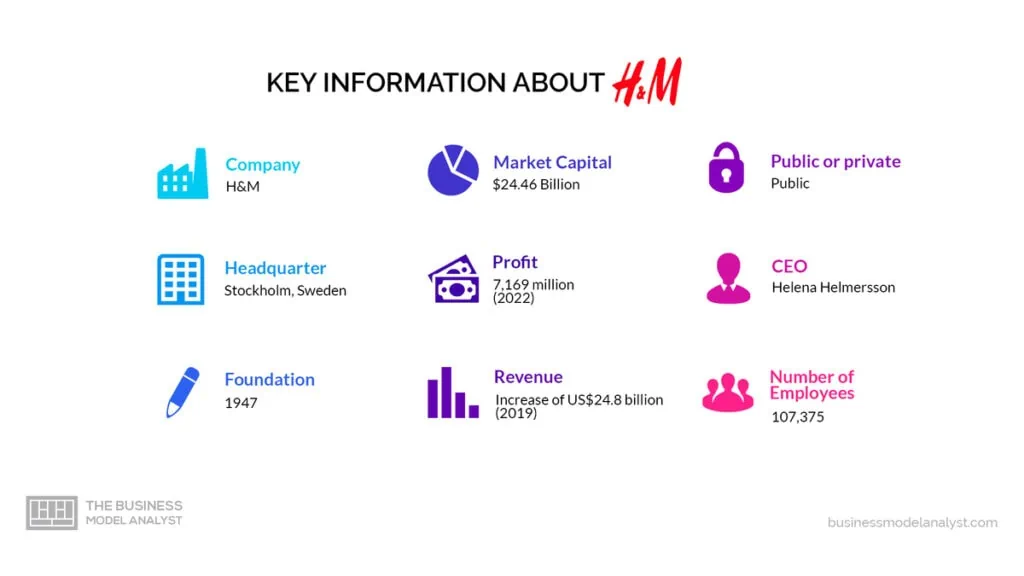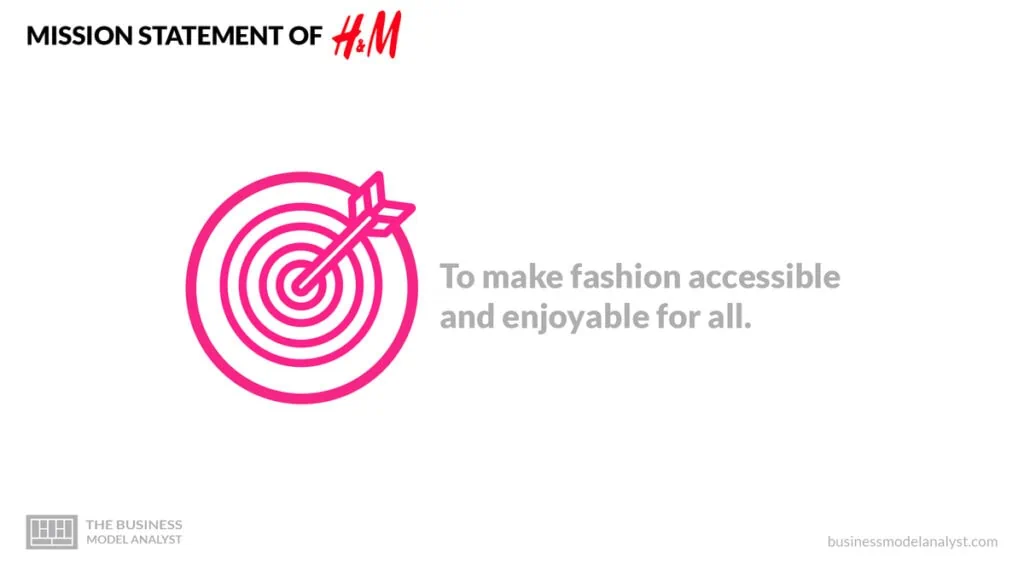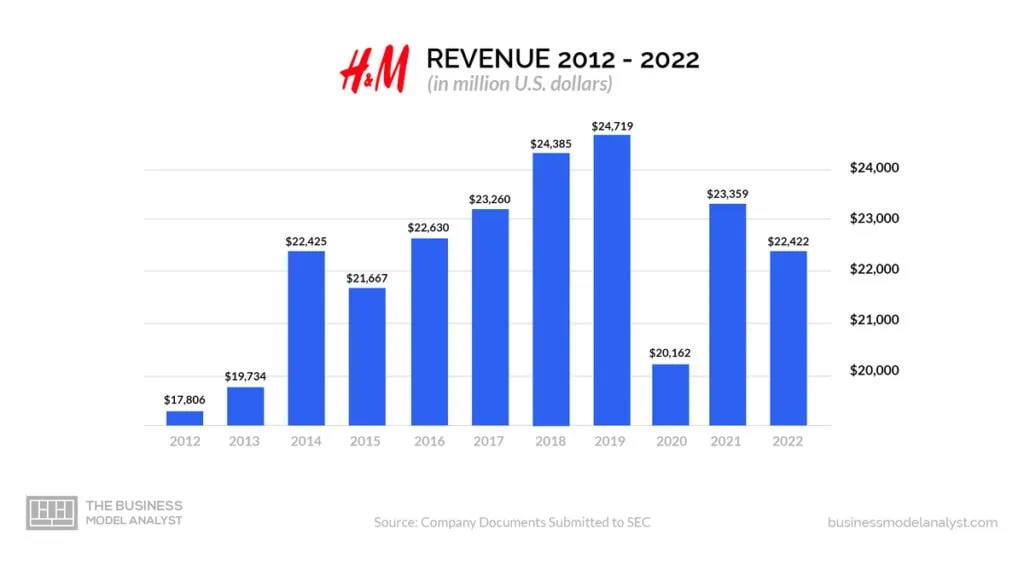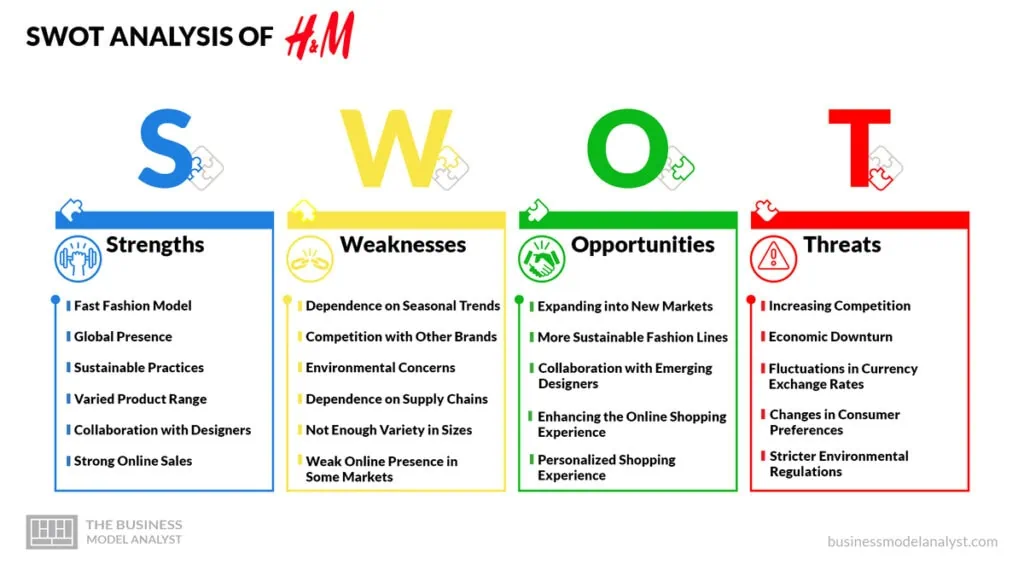When it comes to the world of fashion, H&M is a name you can’t ignore. The H&M business model is one of a kind, focusing on what’s fresh and trendy without breaking the bank. Founded in 1947 in Västerås, Sweden, by Erling Persson, H&M has become a staple in the closets of fashion-conscious folks all around the globe.
You’ve probably seen an H&M store or browsed their website in your city. With 4,801 stores in 75 markets and a friendly online presence, H&M serves up clothing and accessories that cater to the young and the young-at-heart. And it’s not just about the clothes; it’s about providing quality at a price that makes sense. That’s why they raked in an impressive US$24.8 billion in revenue in 2019 alone!
However, their unique business model makes H&M stand out from the crowd and takes them from a single store in Sweden to the second-largest international clothing retailer. In this post, we’re going to peel back the layers and dive into how H&M has built a fashion empire that’s both hip and accessible.

Contents
A brief history of H&M
In 1947, Erling Persson opened a little store in Västerås, Sweden, named Hennes, Swedish for “hers.” This place was all about women’s clothing. Not long after, in 1964, another store popped up in Norway. That was just the beginning!
1968 was a big year for H&M. Erling bought a hunting apparel retailer called Mauritz Widforss in Stockholm. This move brought men’s clothing into the mix, and the store’s name changed to Hennes & Mauritz. The H&M we know today was starting to take shape.
In 1974, H&M made its mark on the Stockholm Stock Exchange. Two years later, in 1976, London welcomed the first store outside Scandinavia. Oh, and let’s remember the start of online shopping with HM.com in 1997!
The year 2000 was a landmark moment for H&M. On March 31st, the doors opened on Fifth Avenue in New York City, marking H&M’s grand entrance into the United States. Did you know H&M also dabbles in home decor? In 2008, H&M started selling home furnishings online, and now you can find them in H&M Home stores worldwide.
H&M didn’t stop at clothes and home furnishings. They launched concept stores like COS, Weekday, Monki, and Cheap Monday, making waves in Asia. H&M was ranked the twenty-first most valuable global brand in 2009 and 2010! From 2,325 stores in 2011 to 3,000 in Chengdu, China, by 2013, H&M’s expansion was unstoppable.
The pandemic hit everyone hard, including H&M. In 2020, they had to close 5% of their global stores, moving most operations online. Sales dipped, but they weathered the storm.
From the UK to Hong Kong, Indonesia to Finland, Chile to the Philippines, and even Melbourne, H&M has made its mark. However, they decided to withdraw from the Russian market in 2022 due to the Russian invasion of Ukraine.
H&M’s fashion reaches far and wide, with raw materials from China, Bangladesh, and India. Sweden is still home to the heart of the operation, where 21 suppliers and factories whip up the stylish clothing and accessories we love.
Who Owns H&M?
Although it’s a public company — meaning anyone can buy a share —, Erling Persson, the founder of H&M, and his family hold a significant part of H&M’s ownership. Stefan Persson, Erling’s son, was the CEO for many years and is now the chairman. He and his family own a substantial portion of H&M’s shares.
As of 2021, Stefan Persson’s holdings were around 32% of the shares, giving him a powerful say in how the company is run. His sister, Lottie Tham, and other family members also own shares, strengthening the family’s influence. H&M is listed on the Stockholm Stock Exchange so that anyone can buy shares in the company. Various investment funds and individual investors hold the remaining portion of the shares.
While the Persson family has a strong influence, H&M’s Board of Directors consists of diverse and talented professionals who guide the company’s direction. Helena Helmersson, the current CEO, leads the company’s global strategy and ensures H&M continues to innovate in the fashion world.
H&M Mission Statement
The H&M mission statement is “to make fashion accessible and enjoyable for all.”

How H&M works
At H&M, fashion moves fast. When you see a trendy item on the runway, you might find something similar at H&M in no time. This quick response to fashion trends is part of what makes H&M so appealing to shoppers.
Behind the scenes, a dedicated team of designers always looks for what’s new and exciting in fashion. They whip up fresh designs every month, brought to life by suppliers and factories across the globe, including China, Bangladesh, and India.
H&M isn’t just about speed, though. They’re committed to responsible and sustainable manufacturing. They ensure that turning a design sketch into a stylish shirt or dress is done right, respecting people and the planet.
Once those new clothes are ready, H&M’s vast distribution network takes over. Whether shopping at a store in Paris or clicking around their website from Tokyo, you’re getting the latest and greatest from H&M.
But what stands out is the price tag. H&M offers up-to-date fashion at prices that won’t break the bank. They work closely with their suppliers and buy in bulk to ensure the savings reach you. And they listen to customers, too. Customer feedback helps H&M understand what works and what doesn’t. It’s all about making sure they offer what people want.
Lastly, H&M is all in on sustainability. From using recycled materials to cutting waste, they’re always looking for ways to be kinder to the Earth.
How H&M makes money

Retail Sales Of Clothing And Accessories: In-Store and Online
Simply put, H&M makes the bulk of its money by selling clothing, accessories, and home decor in its company-operated stores and through its online platform. Whether it’s a trendy dress or a chic sofa cushion, customers flock to H&M for affordable style.
In-store and online sales make up most of H&M’s revenue, keeping the cash registers ringing and the website buzzing.
Franchising and Licensing
H&M also partners with franchisees to open stores worldwide. This approach lets H&M expand into new markets without handling all the day-to-day operations.
H&M earns money by collecting fees from franchisees and providing them with the clothing and other goods they sell. It’s a win-win that helps the brand grow and thrive.
Wholesale Distribution
By selling its products to other retailers, H&M broadens its reach, getting its fashionable items into even more hands. It’s like spreading H&M’s style without opening a new store.
Collaborations and Limited Editions
Sometimes, H&M collaborates with famous designers or celebrities to create special collections. These collaborations create buzz and bring people into stores or onto the website, eager to snag a limited edition piece. The demand for these exclusive items can drive sales and add a touch of luxury to H&M’s offerings.
Subsidiary Brands
H&M’s family includes other brands like COS, Monki, and Weekday. These subsidiaries cater to different tastes and markets, adding to H&M’s income. Each brand has its own unique flair, but they build on H&M’s success.
Sustainability Initiatives
H&M is also exploring innovative ways to make money while being kind to the Earth. From recycling programs to sustainable fabrics, these efforts aren’t just good for the planet and business.
H&M Business Model Canvas
The H&M Business Model can be explained in the following business model canvas:

H&M Customer Segments
H&M customer segments consist of:
- Individual Consumers: H&M serves everyday shoppers looking for fashionable clothing and accessories without spending much. Whether a student or a working professional, people find affordable yet stylish options at H&M;
- Fashion Enthusiasts: Fashion lovers seeking exclusive designer collaborations and unique collections can fulfill their passion for high-end fashion at H&M without the luxury price tag;
- Eco-Conscious Consumers: H&M offers sustainable and eco-friendly products, attracting those who are mindful of the environment and wish to contribute to responsible consumerism;
- Businesses and Retailers: H&M collaborates with various stores and businesses, providing them with products to sell and spreading H&M’s fashion reach further.
H&M Value Propositions
H&M value propositions consist of:
- For Individual Consumers: H&M ensures that fashionable clothing is accessible to all, offering the latest trends at affordable prices. Its vast array of styles means that consumers can find something that fits their taste and budget;
- For Fashion Enthusiasts: H&M provides limited edition collections and collaborations with famous designers and celebrities. These unique offerings allow fashion enthusiasts to indulge in luxury styles without incurring high costs;
- For Eco-Conscious Consumers: H&M’s commitment to sustainability through recycling programs and eco-friendly materials appeals to those who want to shop responsibly. By choosing H&M, they support a brand that values environmental stewardship;
- For Businesses and Retailers: H&M supports global retailers and businesses by providing products for resale or opening franchised stores. Their extensive network and collaboration opportunities make them a go-to partner in the fashion industry.
H&M Channels
H&M channels consist of:
- H&M’s Official Website and Mobile App
- Retail Stores
- Wholesalers and Retailers
- Social Media and Marketing
H&M Customer Relationships
H&M customer relationships consist of:
- Customer Service Support
- Social Media Engagement
- Loyalty Programs
- Feedback and Reviews
H&M Revenue Streams
H&M revenue streams consist of:
- Retail Sales Of Clothing And Accessories: In-Store and Online
- Franchising and Licensing
- Wholesale Distribution
- Collaborations and Limited Editions
- Subsidiary Brands
- Sustainability Initiatives
H&M Key Resources
H&M key resources consist of:
- Physical Assets
- Brand and Reputation
- Design and Innovation Team
- Human Capital
- Supply Chain Network
H&M Key Activities
H&M key activities consist of:
- Fashion Design and Development
- Marketing and Promotion
- Supply Chain Management
- Sustainability Initiatives
H&M Key Partners
H&M key partners consist of:
- Suppliers and Manufacturers
- Designers and Celebrities
- Franchisees
- Environmental Organizations
H&M Cost Structure
H&M cost structure consists of:
- Production and Manufacturing Costs
- Marketing and Advertising
- Store Operations
- Sustainability Efforts
- Research and Development
H&M Competitors
- Zara: Zara is one of H&M’s primary competitors. Zara, founded in 1974, operates in a similar fashion space, offering trendy and affordable clothing. Their quick response to the latest fashion trends sets them apart, making them popular among fashion-conscious consumers;
- Forever 21: Forever 21 has been in the fashion business since 1984 and competes with H&M by offering a wide range of stylish clothing at affordable prices. They appeal to a younger demographic, particularly those looking for trendy, economical fashion options;
- Uniqlo: Uniqlo, a Japanese brand established in 1949, offers high-quality, simple, and comfortable clothing. They focus less on fast-changing fashion trends and more on durability and timeless style. Their approach to fashion places them in a unique position among H&M’s competitors;
- GAP: GAP, founded in 1969, is known for its classic American style. With an emphasis on quality and timeless pieces like jeans and t-shirts, GAP appeals to those looking for a more relaxed and consistent fashion statement. Their commitment to classic styles sets them apart in the market;
- Topshop: Topshop, a British company that started in 1964, competes with H&M by offering fashionable clothing with a unique British flair. They keep their collections fresh and updated, appealing to those interested in chic and contemporary fashion;
- Primark: Primark, established in 1969 in Ireland, is another key competitor to H&M. They focus on providing a wide range of fashion items at remarkably low prices. Their commitment to budget-friendly shopping makes them an attractive option for price-conscious consumers.
H&M SWOT Analysis
Below, there is a detailed swot analysis of H&M:

H&M Strengths
- Fast Fashion Model: H&M is known for its fast fashion model, quickly turning the latest trends into affordable clothing for customers. This lets people buy the newest styles without spending a fortune. It’s a big part of what makes H&M stand out from other clothing stores;
- Global Presence: H&M stores are in big cities and small towns alike. This wide reach helps them reach more customers and makes it easier for people to shop at H&M no matter where they live;
- Sustainable Practices: H&M is working hard to be more environmentally friendly. They have programs to recycle clothes and use more sustainable materials. This appeals to customers who care about the planet and want to make responsible shopping choices;
- Varied Product Range: H&M doesn’t just sell one type of clothing; they have something for everyone. From everyday wear to business attire and even home goods, the variety keeps customers returning for more;
- Collaboration with Designers: H&M often works with famous designers to create unique collections. These partnerships create excitement and bring in customers who want designer looks at H&M prices;
- Strong Online Sales: H&M’s online store makes shopping easy and convenient. People can browse and buy from the comfort of their homes, and the user-friendly website makes the whole process a breeze;
- In-House Design Team: H&M’s talented designers work right at the company, keeping an eye on the latest fashion and ensuring H&M’s clothes are up-to-date and stylish. This helps them stay ahead of the competition.
H&M Weaknesses
- Dependence on Seasonal Trends: H&M’s business relies heavily on fashion trends that change with the seasons. If they miss out on a trend, it could affect their sales. They must always have their finger on the pulse of what’s hot in fashion;
- Competition with Other Brands: There are a lot of stores that sell similar clothes to H&M, sometimes at lower prices. This makes it tough for H&M to stand out and can affect how many people choose to shop there;
- Environmental Concerns: Though H&M is working on sustainable clothing lines, they still face criticism for some of their production methods that may not be as friendly to the environment. This can cause some shoppers to choose to shop elsewhere;
- Dependence on Supply Chains: Clothes must be made, shipped, and put on shelves, and any hiccup in that process can cause problems. Delays with suppliers or shipping can lead to empty shelves and unhappy customers;
- Not Enough Variety in Sizes: Everyone’s body is different, and not all H&M stores carry a wide range of sizes to fit everyone. This can make it hard for some customers to find what they need, and they might shop elsewhere;
- Weak Online Presence in Some Markets: Online shopping is a big deal, but in some places, H&M’s online store might not be as strong as it could be. This can make it hard for people to shop from the comfort of their homes and might lead them to other online stores;
- Inconsistent Quality Across Products: Sometimes, the quality of clothes at H&M can be hit or miss. One shirt might be great, while another might not last as long. Inconsistent quality can make shoppers think twice before buying.
H&M Opportunities
- Expanding into New Markets: H&M has a chance to grow by opening stores in places where they don’t yet have a presence. They can reach more people and build their customer base by entering new countries or towns;
- More Sustainable Fashion Lines: People care more about the environment, and H&M can meet this demand by creating even more clothing lines made from recycled or sustainable materials. This could bring in customers who want to shop responsibly;
- Collaboration with Emerging Designers: H&M has worked with famous designers, but what about the up-and-comers? By partnering with new and exciting talents, H&M could create unique collections that stand out in the crowded fashion market;
- Enhancing the Online Shopping Experience: Online shopping is extensive and only getting bigger. H&M can improve its online store with faster shipping, better website features, or exclusive online sales. This could make shopping at H&M even more appealing;
- Personalized Shopping Experience: Imagine walking into an H&M store and finding exactly what you want, tailored to your style and size. Using technology and data, H&M could create a personalized shopping experience that would wow their customers and keep them coming back;
- Developing a Loyalty Program: Everyone likes rewards, right? H&M could create a loyalty program that gives customers points or discounts for shopping with them. It’s a simple way to say “thank you” and encourage more shopping;
- Investing in Community Outreach: H&M can become a bigger part of the communities it serves by supporting local causes or hosting community events. This shows they’re not just a store, but a neighbor who cares.
H&M Threats
- Increasing Competition: More and more stores offer similar fashion to H&M. Some are even doing it at lower prices. This means that H&M has to work extra hard to stay ahead and keep people coming to their stores;
- Economic Downturn: When the economy isn’t doing well, people usually spend less on things like clothes. H&M could feel the pinch if people decide to tighten their belts and not shop as much;
- Fluctuations in Currency Exchange Rates: H&M operates in many different countries; sometimes, money is worth more in one place than another. If exchange rates shift, it might affect how much money H&M makes;
- Changes in Consumer Preferences: Fashion is always changing. What’s popular today might not be popular tomorrow. If H&M doesn’t keep up with what people want, it could be bad for business;
- Stricter Environmental Regulations: People are paying more attention to how things are made and where they come from. If governments decide to make rules about how clothes are made, it might mean that H&M has to change how they do things. This can be challenging and costly;
- Social Media Backlash: In today’s world, word spreads fast, especially on social media. If H&M does something people don’t like, it could quickly become a big problem. They need to be mindful of their actions and how people might react;
- Supply Chain Disruptions: Getting clothes from the factory to the store is a big job. If something goes wrong, like a strike at a shipping port or bad weather, it could delay getting clothes on the shelves;
- Potential Tariffs and Trade Restrictions: Sometimes, countries put extra taxes on things from other places. If this happens with clothing, it could make it more expensive for H&M to get the clothes they sell or make them more expensive for customers.
-> Read More About H&M’s SWOT Analysis.
Conclusion
H&M is a global leader in fashion, known for offering stylish and affordable clothing. They’ve made strides in environmental responsibility and have a strong presence in stores and online.
Facing challenges like competition, they continue to see opportunities to grow and evolve. H&M’s focus on being accessible to everyone while still being conscious of trends and sustainability sets them apart in the fashion industry. Their commitment to providing value without sacrificing style makes them a standout name in the world of retail.
So, if you’ve ever wondered what H&M is all about, now you know. They’re a fashion friend, a global neighbor, and a business that’s always looking for the next big thing. It’s a mix of style, smarts, and heart, making H&M a name to remember.

